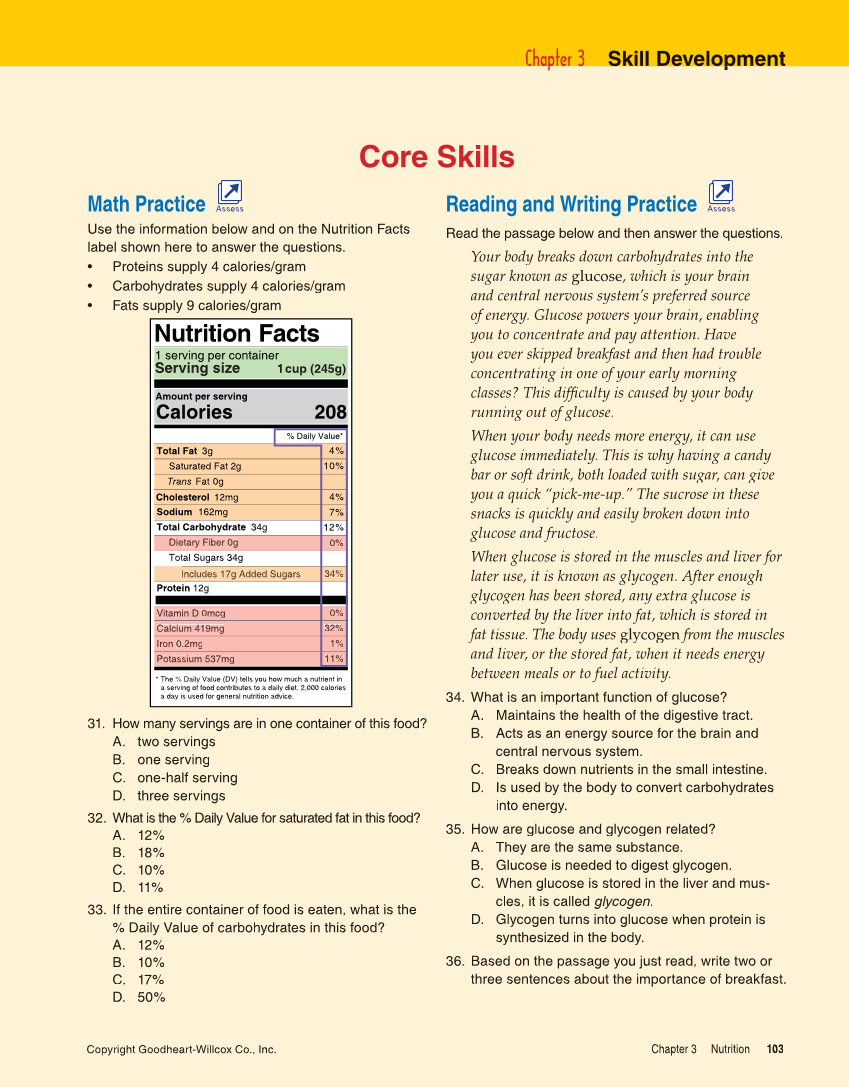Copyright Goodheart-Willcox Co., Inc. Chapter 3 Nutrition 103 Math Practice Use the information below and on the Nutrition Facts label shown here to answer the questions. • Proteins supply 4 calories/gram • Carbohydrates supply 4 calories/gram • Fats supply 9 calories/gram 31. How many servings are in one container of this food? A. two servings B. one serving C. one-half serving D. three servings 32. What is the % Daily Value for saturated fat in this food? A. 12% B. 18% C. 10% D. 11% 33. If the entire container of food is eaten, what is the % Daily Value of carbohydrates in this food? A. 12% B. 10% C. 17% D. 50% Chapter 3 S S kill Development p Core Skills Reading and Writing Practice Read the passage below and then answer the questions. Your body breaks down carbohydrates into the sugar known as glucose, which is your brain and central nervous system’s preferred source of energy. Glucose powers your brain, enabling you to concentrate and pay attention. Have you ever skipped breakfast and then had trouble concentrating in one of your early morning classes? This diffi is caused by your body ficulty running out of glucose. When your body needs more energy, it can use glucose immediately. This is why having a candy bar or soft drink, both loaded with sugar, can give you a quick “pick-me-up.” The sucrose in these snacks is quickly and easily broken down into glucose and fructose. When glucose is stored in the muscles and liver for later use, it is known as glycogen. After enough glycogen has been stored, any extra glucose is converted by the liver into fat, which is stored in fat tissue. The body uses glycogen from the muscles n and liver, or the stored fat, when it needs energy between meals or to fuel activity. 34. What is an important function of glucose? A. Maintains the health of the digestive tract. B. Acts as an energy source for the brain and central nervous system. C. Breaks down nutrients in the small intestine. D. Is used by the body to convert carbohydrates into energy. 35. How are glucose and glycogen related? A. They are the same substance. B. Glucose is needed to digest glycogen. C. When glucose is stored in the liver and mus- cles, it is called glycogen. D. Glycogen turns into glucose when protein is synthesized in the body. 36. Based on the passage you just read, write two or three sentences about the importance of breakfast. Assess Assess 4% 10% 4% 7% 12% 0% 0% 32% 1% 11% 34% 162mg 3g Nutrition Facts Calories 208 Amount per serving Total Fat Saturated Fat 2g Trans Fat 0g Cholesterol 12mg Sodium Total Carbohydrate 34g Dietary Fiber 0g Total Sugars 34g Includes 17g Added Sugars Protein 12g Vitamin D 0mcg Calcium 419mg Iron 0.2mg Potassium 537mg % Daily Value* The % Daily Value (DV) tells you how much a nutrient in a serving of food contributes to a daily diet. 2,000 calories a day is used for general nutrition advice. * 1 serving per container Serving size 1cup (245g) 0% 32% 1% 11% Vitamin D 0 mc g Calcium 419m g Ir on 0 .2m g P otassium 537m g 0% D ietary Fiber 0g 34% I ncludes 17g Added Sugars
